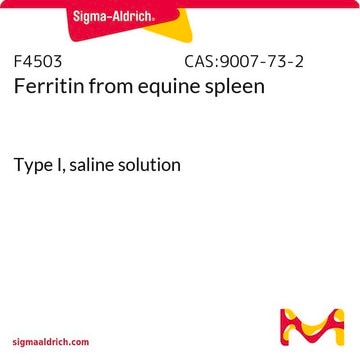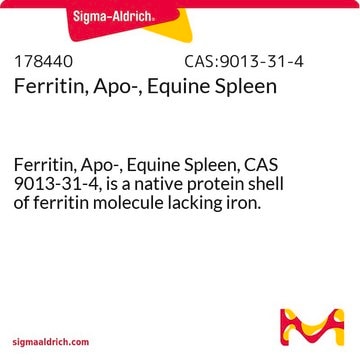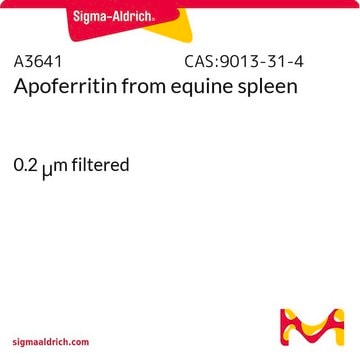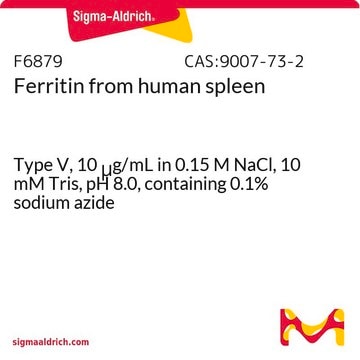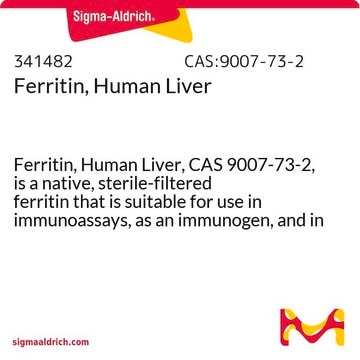F7879
Ferritin, cationized from horse spleen
10 mg/mL in 0.15 M NaCl
Se connecterpour consulter vos tarifs contractuels et ceux de votre entreprise/organisme
About This Item
Produits recommandés
Source biologique
horse spleen
Niveau de qualité
Stérilité
sterile-filtered
Forme
liquid
Concentration
10 mg/mL in 0.15 M NaCl
Technique(s)
cell culture | mammalian: suitable
electron microscopy: suitable
Numéro d'accès UniProt
Température de stockage
2-8°C
Informations sur le gène
horse ... FTL(100051593)
Description générale
Ferritin, an iron-storage protein is usually present in the liver and spleen in mammals. Iron and ferritin are distributed relatively same in the eye. Ferritin is made up of heavy and light chains.
Application
A cationic derivative used to label negatively charged cell membranes for visualization by electron microscopy.
Ferritin is an iron storage protein that plays a central role in iron metabolism, and may be elevated in inflammatory or malignant diseases. It has been used in studies as an indicator of body iron supply, but may prove inaccurate in in the presence of chronic inflammation.
Ferritin, cationized from horse spleen has been used:
- to incubate amoebae (106) in the study, to determine whether trophozoites are able to take up ferritin and internalise this protein for their growth in axenic culture
- to determine phagosome-lysosome fusion by electron microscopy
- to label freshly excised chick optic tecta in serum free incubation medium
Actions biochimiques/physiologiques
Ferritin holds iron at its ferric state (Fe3+). The core of ferritin has the capability to hold 4500 iron molecules. It is essential to store iron in vertebrates. Ferritin is also essential to store and transport iron in invertebrates. It plays a key role in dietary iron absorption.
Notes préparatoires
Prepared by coupling horse spleen ferritin with N,N-dimethyl-1,3-propanediamine (DMPA).
Code de la classe de stockage
10 - Combustible liquids
Classe de danger pour l'eau (WGK)
WGK 2
Point d'éclair (°F)
Not applicable
Point d'éclair (°C)
Not applicable
Certificats d'analyse (COA)
Recherchez un Certificats d'analyse (COA) en saisissant le numéro de lot du produit. Les numéros de lot figurent sur l'étiquette du produit après les mots "Lot" ou "Batch".
Déjà en possession de ce produit ?
Retrouvez la documentation relative aux produits que vous avez récemment achetés dans la Bibliothèque de documents.
Les clients ont également consulté
Fabrizio Bardelli et al.
Scientific reports, 7, 44862-44862 (2017-03-24)
Once penetrated into the lungs of exposed people, asbestos induces an in vivo biomineralisation process that leads to the formation of a ferruginous coating embedding the fibres. The ensemble of the fibre and the coating is referred to as asbestos
Interaction of Legionella pneumophila with Acanthamoeba castellanii: uptake by coiling phagocytosis and inhibition of phagosome-lysosome fusion.
Bozue J A and Johnson W
Infection and Immunity, 64(2), 668-673 (1996)
R H Adamson et al.
The Journal of physiology, 445, 473-486 (1992-01-01)
1. We have investigated the interaction of plasma proteins with the endothelial cell using cationized ferritin as a marker of the cell surface glycocalyx. 2. Single microvessels of the frog mesentery were sequentially perfused using glass micropipettes with solutions containing
Jennifer R Charlton et al.
American journal of physiology. Renal physiology, 321(3), F293-F304 (2021-07-21)
Kidney pathologies are often highly heterogeneous. To comprehensively understand kidney structure and pathology, it is critical to develop tools to map tissue microstructure in the context of the whole, intact organ. Magnetic resonance imaging (MRI) can provide a unique, three-dimensional
Iron-Induced Retinal Damage
Handbook of nutrition, diet, and the eye, 619-626 (2014)
Notre équipe de scientifiques dispose d'une expérience dans tous les secteurs de la recherche, notamment en sciences de la vie, science des matériaux, synthèse chimique, chromatographie, analyse et dans de nombreux autres domaines..
Contacter notre Service technique